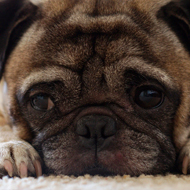Can brachycephalic dogs be healthy?

The panel agreed on the importance of reducing the demand for pugs, French bulldogs and bulldogs.
Tackling the use of brachycephalic dogs in advertising and working with breeders and owners will be key to improving their welfare, a panel of vets agreed at BSAVA Congress yesterday (6 April).
But can these breeds ever be truly healthy? This question divided the panel, which comprised a diverse range of voices - from TV vet Emma Milne, who recently launched the campaign Vets Against Brachycephalism; to Nick Blayney, chair of the Kennel Club's Dog Health Group.
Jane Ludlow of the University of Cambridge, said there are healthy examples of these breeds; those that can self-whelp and have grade zero BOAS scores. However, there are lots of problems "that we should not ignore". There are also highly brachycephalic breeds such as the griffon bruxellois that we know little about from a disease perspective compared to the 'high profile' breeds.
Comparing photos of wild canids and brachycephalic dogs, Emma Milne said it is "indefensible" that humans have selectively bred in these extreme traits. She stated that she does not believe these breeds can be healthy and called for an end to human "obsession" with appearance over health.
"I'm tired of hearing that there are some that can breathe, some that are grade zero," she added. "They should all be grade zero. Why have we become so habituated that we accept this is 'normal for the breed'?…
"We almost certainly can make healthier brachycephalics, but they are still brachycephalics."
Ludlow, however, urged vets to be cautious in the way they speak to owners and breeders about this issue.
"I think we need to be a little bit wary of alienating these clients," she explained. "We don't want to be in a position where these dogs don't come into the practice because they see vets as the enemy."
Similarly, Nick Blayney argued: "Latent hostility does not drive persuasion, it drives people away".
Defending the Kennel Club, he said it has "very little authority, except in its own show rings", and only three per cent of puppies are from Assured Breeders, while 28 per cent of puppies are registered with the club. However, he said the club does recognise its responsibility to promote healthy dogs.
While many vets have raised concerns about the wording of some of the breed standards, Mr Blayney said problems usually arise due to "misinterpretation" of the standards and irresponsible breeders.
Milne, however, said she would "take him to task on this", citing the pug breed standard, which states that they should never be lean or leggy. She showed a photo of a Crufts contestant that appeared to be morbidly obese, pointing out that the dog would have won competitions in order to make it as far as Crufts.
What the panel did agree upon, was the importance of reducing the demand for pugs, French bulldogs and bulldogs, through tackling their use in advertising and celebrity endorsements. Working with owners and breeders to raise awareness and recognition of the health issues suffered by these breeds, is also key.
And ultimately, panellists said the vet's primary responsibility is to treat the animal in front of them, whether they are brachycephalic or not. Consultations do, however, provide an opportunity to educate clients.
Figures quoted throughout the day showed the number of French bulldog puppies registered with the Kennel Club soared to around 31,000 last year. This enormous figure represents only registered dogs. By the time these puppies reach the age of around three, it is likely that vets around the country will see a 'tidal wave' of dogs coming into clinics.



 The BSAVA has opened submissions for the BSAVA Clinical Research Abstracts 2026.
The BSAVA has opened submissions for the BSAVA Clinical Research Abstracts 2026.